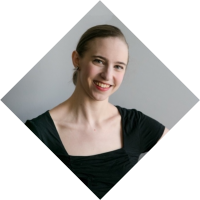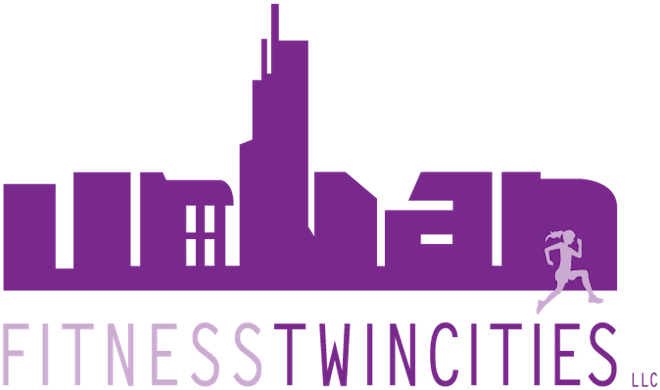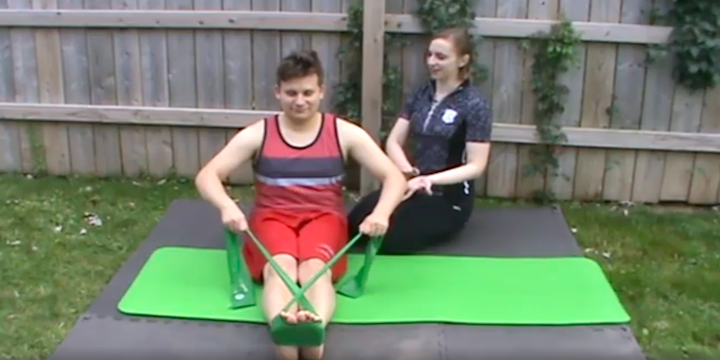This exercise is amazing at strengthening your arm and upper back muscles!
This exercise targets a number of different muscles but, when done correctly, especially works your triceps, lats and shoulder blade muscles. It is wonderful for helping reduce under arm flab and building scapular strength. This exercise has a lot of moving parts, or, more accurately, a lot of potential moving parts that you want to keep stable. To get the most out of this exercise check out our tips below along with those in the video!
Remember these things when setting up:
- You want to be sitting tall, right up on your sit bones. If you have trouble sitting up with a straight back with your legs straight out in front, you can try sitting up on a pillow; rolled up blanket, towel, or mat; bosu ball; or, if none of those work, on sturdy, non-cushy chair with your feet on a stool.
- You will need a stretchy band. A flat band works best, as it doesn’t slide off your feet, but you can use the rolled or round stretchy band in a pinch.
- Use a lighter weight band until you get used to the isolation of the arm in the shoulder joint.
Use these tips to help get the most out of this exercise:
- Stay seated with a straight back the whole time. Your spine stays perfectly still.
- Keep the ears and hips reaching away from each other at all times.
- Keep low abs pressed gently into your spine the whole time.
- Keep the sternum reaching down through the tailbone (chest relaxed) and the collar bone up towards the ears to create space in your chest, top to bottom.
- Shoulder roll your shoulders front to back and keep them back. Then reach the bottom of your shoulder blades wide away from or off your spine towards the sides of your body.
- Once set, shoulder blades stay perfectly still and stable. There should be no shoulder blade movement.
- If you have trouble knowing if you are sitting up straight and/or if your scapula are moving, sit with your back up against a wall. Your back should be flat against the wall top to bottom and side to side the whole time. If you feel your shoulders moving off the wall or pressing more into it as your arms move, your scapula are moving. The shoulder blades should stay flat against the wall the whole time.
- Center of the chest reaches wide through the biceps the whole time. This is usually easiest to feel as the elbows go back and more difficult to keep as you straighten the elbows back in front of you.
- Imagine light moving from your chest through your biceps and out your fingers to keep the strength and energy flowing equal the whole time.
- Imagine you have the biggest diamond necklace on and it stretches from shoulder to shoulder and top to bottom of your chest. If you let your shoulders round forward or chest collapse, you will hide your diamonds. Keep each diamond showing and shining.
- Center of the back opens through the scapula and all the way out through the triceps and elbows. This is crucial to helping keep the scapula stable.
- Imagine light moving from the center of your back through the back of your arms and out your fingers to keep the strength and energy flowing equal the whole time.
- Chest and back reach or spread open wide into the arms equally at all times.
- Bottoms and tops of the elbows reach equally away from the body as the arms move or elbows bend. This will help keep the shoulders down and the scapula wide at the base of the shoulder blade.
- Elbows are always in front of you, even as you bend them. Only the most flexible in their chests can get their elbows straight out to the side in this exercise. Smaller is better than going too far with this exercise.
- Push the biceps away from each other to bend the elbows or move the arms away from each other. Push the triceps toward each other to bring the elbows or arms back towards each other.
- Keep a little support underneath the back of the armpits, like when you pick up a small child from behind. That way your shoulders will be supported from underneath, making it easier to stay out of the neck.
- Keep the inside of the elbows facing each other or straight in front of you. If they face the ceiling, you won’t work that chicken wing muscle.
- Palms can face you or the floor or do one set one way and one the other.
Give it a try with our video!
Looking for more shoulder and/or arm exercises? Schedule your free 90 minute consultation.

This blog was contributed by our Pilates guru, Kaethe Birkner. Kaethe is a certified Pilates instructor through Balanced Body and dances ballet professionally at Continental Ballet Company. She has been teaching Pilates since 2012 and has been taking Pilates since 2004.

